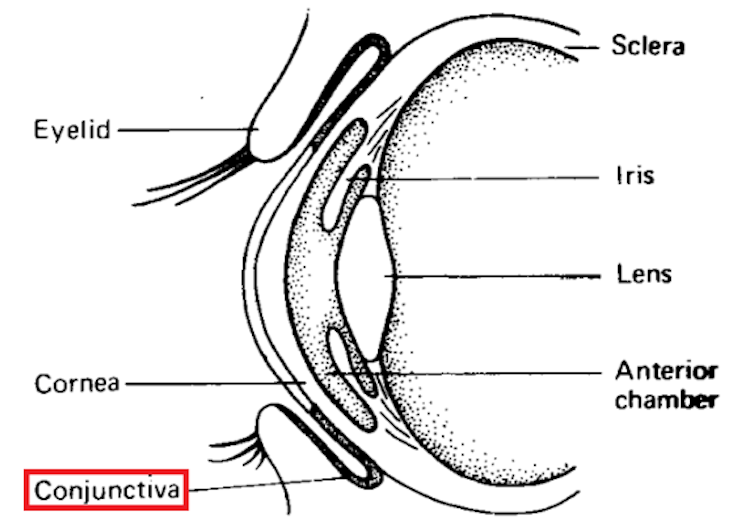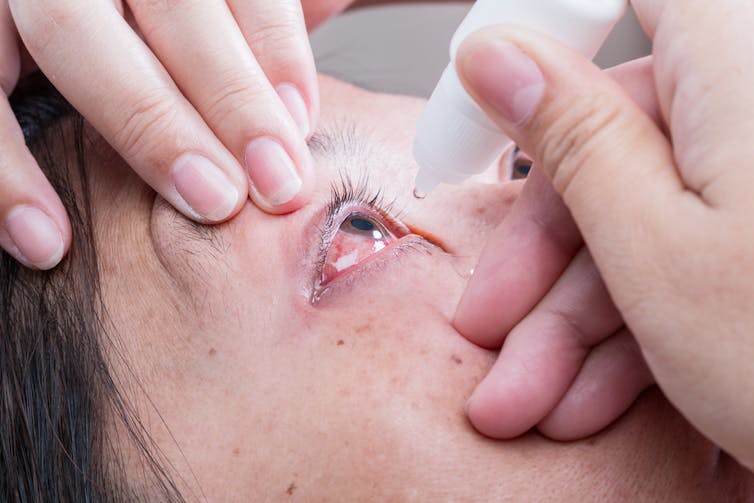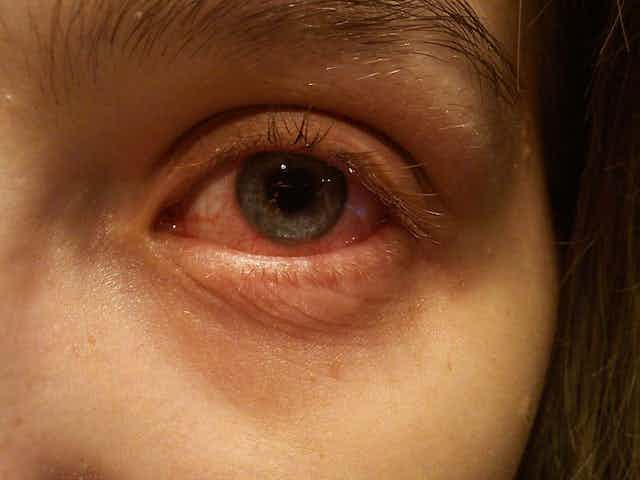Conjunctivitis is an eye disease that has been described since antiquity. Ancient Roman oculists, the eye physicians of the time, prescribed remedies such as vinegar lotions and copper oxide for its treatment.
Though the treatments have changed over the last 2,000 years, the disease has not. Conjunctivitis is inflammation of the conjunctiva, the normally transparent membrane that sits atop the sclera (the white part of the eye). It can affect one or both eyes and commonly causes redness, grittiness, irritation, itchiness and discharge that can be watery (like tears) or sticky (pus).
The conjunctiva: the eyeball’s protective coat
The conjunctiva is a thin, transparent mucous membrane that is about 33 microns thick (roughly the same thickness as two sheets of cling wrap stuck together). It lines the front part of the eyeball over the white sclera as well as the inner aspect of the eyelids, forming a continuous layer that physically prevents debris such as fallen eyelashes from migrating to the back of the eye socket.
The conjunctiva secretes mucus and tears to help lubricate the eye, and contains immune cells and tissue that help to prevent infection. Its rich supply of blood vessels dilate in response to irritation and inflammation. This leads to the distinctive red eye that occurs in conjunctivitis, dry eye, tiredness and other eye diseases.
Conjunctivitis may be divided into three main categories according to cause.

Viral conjunctivitis
Viral conjunctivitis is the most common form of infectious conjunctivitis. A virus called adenovirus (which also causes respiratory infections and diarrhoea) is responsible for 65-90% of all cases of viral conjunctivitis. Other viruses, such as herpes simplex virus (also responsible for cold sores) and varicella zoster virus (also responsible for chicken pox), can also cause conjunctivitis.
The affected eye is red, itchy, irritated and gritty and produces watery discharge similar to tears. The virus commonly affects one eye first before quickly spreading to the other eye. It may be accompanied by a sore throat or runny nose typical of a common cold.
It occurs more frequently in adults than in children. Eye secretions and droplets from the respiratory tract of infected people transmit the virus. Because it is highly contagious, it often causes epidemics in schools and workplaces and among household members.
No effective antiviral medication currently exists for viral conjunctivitis. Antibiotic eye drops are not effective.
Treatment is aimed at symptom relief. This involves lubricating eye drops, cold compresses and antihistamine eye drops (if itching is troublesome).
The disease usually self-resolves in two to three weeks.
Bacterial conjunctivitis
Bacterial conjunctivitis is less common than viral conjunctivitis. It is caused by bacteria such as Streptococcus pneumoniae, Staphylococcus aureus, Moraxella catarrhalis and Haemophilus influenzae.
These bacteria are members of the normal colonies living on healthy eyes and usually do not cause disease. However, they can proliferate and cause conjunctivitis in certain conditions, such as dry eye, after damage to the eye, or in a weakened immune system. More commonly, though, these bacteria simply cause conjunctivitis when transmitted from an infected person to a non-infected person.
Like viral conjunctivitis, bacterial conjunctivitis is contagious. One or both eyes may be involved and they are also red, irritated and gritty. However, bacterial conjunctivitis usually produces a sticky whitish or yellowish discharge like pus, in contrast to the watery tears of viral conjunctivitis.
Broad-spectrum antibiotic eye drops, such as chloramphenicol (Chlorsig, available over the counter at pharmacies), are effective in reducing how long the symptoms of bacterial conjunctivitis last. However, it is important to note bacterial conjunctivitis frequently resolves even without treatment.
Less commonly, Neisseria gonorrhoeae (gonorrhoea) and Chlamydia trachomatis (chlamydia) can cause conjunctivitis. These typically occur in sexually active young adults with direct or indirect eye exposure to infected genital secretions, or in babies born via vaginal delivery to infected mothers.
These diagnoses should be suspected in any case of conjunctivitis that features excessive pus-like discharge, or fails to respond to standard antibiotic eye drops. These conditions should be assessed promptly by an ophthalmologist.
Allergic conjunctivitis
Allergic conjunctivitis is triggered by exposure to allergens. These include pollen, dust mites and animal dander (microscopic flecks of skin). Because it is not caused by micro-organisms, this condition is not contagious and avoiding school or work is not required.
Redness, itchiness and watering of both eyes are the prominent features. These may be accompanied by an itchy nose, itchy throat and sneezing.
Identifying and avoiding the offending allergen(s) is important for treatment. This may require an allergy test.
Symptom relief can be achieved through lubricating eye drops, cold compresses and antihistamine eye drops and tablets. These are available over the counter at pharmacies.
However, eye drops containing the active ingredients antazoline and naphazoline (vasoconstrictors*, which reduce redness) should not be used for long periods as these may cause a rebound red eye when they are stopped.

I think I have conjunctivitis – what now?
It is important to note that pain, sensitivity to light and visual disturbances are not features of conjunctivitis. These may indicate a sight-threatening eye disease which requires urgent treatment by an ophthalmologist. A visit to the nearest hospital emergency department is warranted if any of these symptoms occur.
With any case of suspected conjunctivitis, first, stop wearing contact lenses (if you do) for the duration of the episode, and see your GP. If necessary, your GP can refer you to an ophthalmologist or ophthalmology walk-in clinic to ensure you do not have a more serious variety such as herpes simplex, varicella zoster, chlamydia or gonorrhoea.
People with viral or bacterial conjunctivitis should avoid work or school and public swimming pools until symptoms settle; avoid sharing towels and make-up items; avoid rubbing the affected eye(s); and practise thorough and frequent hand hygiene, especially after touching the face or eyes, sneezing or coughing.
Dr Cameron McLintock, ophthalmology registrar at Queensland Health, contributed to this article.
*This article originally said eye drops containing the active ingredients antazoline and naphazoline were antihistamines rather than vasoconstrictors, which reduce eye redness. This has now been corrected.

